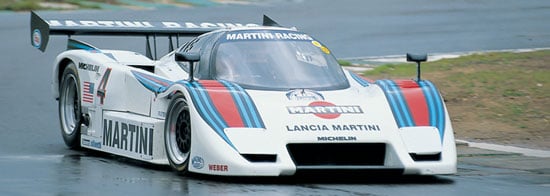
The following is an edited extract from Auto Italia magazine, August 2004. For access to the full feature, plus articles on the Lamborghini Islero GT, the Auto Italia Concours at Stanford Hall, the 2004 Maserati Quattroporte and much more, see www.auto-italia.co.uk
Legend has it that when Cesare Fiorio and the top brass of Martini Racing first set eyes on the 1982 Porsche 956 Group C car, their collective eyebrows rose considerably and they all took a very large corporate gulp of air. The weapon they intended to use against the formidable Porsche was revealed to a startled press in the first week of February 1983, appropriately in Martini’s own museum in Pessione, east of Turin.
 The new car was called LC2 and once the decision had been taken in mid-summer 1982 to build it, Lancia had not spared itself in developing the bases of the new machine. The significance of what they had seen at Silverstone was not lost on them; what they had decided to do was meet the might and experience of 20th Century Porsche face-to-face. This time there were to be no Fiorio rule-bending tricks and this was an arena in which Zuffenhausen was considered to be the undisputed king. The LC2 was a brave and courageous project and it was about to enter the lion’s den.
The new car was called LC2 and once the decision had been taken in mid-summer 1982 to build it, Lancia had not spared itself in developing the bases of the new machine. The significance of what they had seen at Silverstone was not lost on them; what they had decided to do was meet the might and experience of 20th Century Porsche face-to-face. This time there were to be no Fiorio rule-bending tricks and this was an arena in which Zuffenhausen was considered to be the undisputed king. The LC2 was a brave and courageous project and it was about to enter the lion’s den.
The Project Engineer was Gianni Tonti responsible for the whole Lancia Group C set-up. Ing Gianpaulo Dallara looked after chassis construction at his Varano factory although much design work was shared between various Fiat companies and in-house Abarth designers. A full-scale mock-up was tested in the Fiat Research Centre at Orbassano and the end result was a state-of-the-art ground-effects sportscar incorporating the flat bottom demanded by the rules.
The gearbox was by Hewland as commonly used by other Group C cars, but the engine was a turbocharged V8 from Ferrari, reportedly a purpose-built unit although with overall design based on the then current 308. The 2599cc V8 with Weber electronic injection and two KKK turbochargers was reported to be good for 650bhp on race boost. Group C was essentially a fuel-consumption formula, so it was no good just going for horses. Porsche, in typically understated manner, reckoned that they would probably only have 600bhp available.
The LC2 was primarily designed around Pirelli radial tyres and this was where the problems started. At Monza for the first 1000km race of 1983, despite Ghinzani taking pole from a surprised works Porsche team and drawing out a lead in the race, a rear tyre exploded as early as lap eight and the challenge was gone. By mid-season, the engines were found to be suffering from porous heads leading to overheating. Then came even worse news. Pirelli was supplying tyres to F1, World Rallying and the LC2s. The tyre company could not keep up with demand and chose to abandon endurance racing. Tonti and Fiorio were forced to take up Dunlops for the rest of the season, but they were crossplies and totally unsuitable, becoming unstable and lacking traction – just what you need with a long-distance racing car developing 650bhp.

Sheer hard work resulted in a late-season win at the Imola 1000km and a second at Kyalami, but changes were needed. Over the winter a lot of testing was completed mostly with the aim of improving reliability and handling. The suspension was redesigned so that the cars could run properly on crossply Dunlops. The gearboxes were also redesigned and the aerodynamics updated. The cars now required unique wheel sizes and Fiorio had some Speedline three-piece rims specially made for the tyres. There was definitely a feeling that this could be Lancia’s year.
The ’84 season opened at Monza and Patrese was going for pole when one of the wheel seams split open approaching Lesmo. Fiorio was forced to revert to the cars’ ’83 size wheels and tyres so the winter’s testing was wasted and because the car was designed around the use of particular tyres, the nervous handling returned and the results suffered.
Our featured car here, chassis LC2-84 003, later 003b, flattered to deceive at the next 1,000km race at Silverstone, coming home third but ailing in the hands of Mauro Baldi/Paolo Barilla. By this time the team had at least got a supply of the correct size wheels. Before Le Mans, where 003 ran again, new engine management electronics allowed a larger capacity motor to be introduced bringing its size up to a full three litres, still with twin turbos. Power had been 720bhp for qualifying reduced to 660 in race trim; with the 3014cc unit, up to 828bhp was available and the cars led convincingly until transmission problems arose. Never one to miss out on the chance of a little intrigue Fiorio didn’t mention the 3.0-litre to the press at La Sarthe, even though one car used the new unit for the race. At the Nürburgring, the next event, he was obviously enjoying telling everyone about it judging by the ‘I knew something you didn’t’ smile on his face.
He didn’t have much else to be happy about. An obscure turbo oiling fault – on components used for years with no problems – and misfires cursed the bulk of the season. Speed wasn’t a problem short-term, the LC2 time and again proving itself faster than the 956/962, but over longer distances a variety of problems haunted the team. In June Chief Engineer Tonti left to go to the Alfa Euroracing F1 team, his place taken by Ing Lombardi. As a morale booster, the team achieved a 1-2 finish at the late-season Kyalami race but it was achieved against negligible opposition.
A huge amount of work took place over the 1984/85 winter with Ferrari Formula 1-type electronics fitted to the engines, new camshafts, a switch to Michelin tyres and yet further altered suspension and the widening of the cars to make full use of the regulatory dimensions. Once again, it all seemed to work and at Monza, in our 003, Patrese was a massive seven seconds a lap quicker than in ’84 and left Porsche gasping.
It would be a huge pleasure to tell the story of how the LC2-85s swept all before them, but the niggles continued to test Fiorio’s sanity and Martini Lancia’s (so far) seemingly remarkably lenient bean-counters. Nannini was clearly shaping up to win at Monza when high winds blew a tree across the track stopping the race! See what I mean by bad luck? At Silverstone he was in the lead when a wheel bearing failed, at Le Mans an early lead evaporated and at Hockenheim with a win in sight, the fuel pump failed to pick up the last few litres of petrol.
At Brands the two team cars led easily until hitting each other at Druids, but at Spa that elusive World Sportscar Championship victory was finally achieved and, what’s more, it was achieved by our car pretty much in the configuration you see it here. Sadly this was the race where Stefan Belloff lost his life so the Lancia team had little to celebrate.
The potential for the LC2-85 was immense as proven by no less than five pole positions during the year, but the continuing drought of wins sapped Martini Lancia’s energy and most were surprised when a much-developed car appeared at Monza in 1986. However, this and Silverstone were to be the last Martini LC2 appearances.
Italian privateer Gianni Mussato had bought our 003 and updated it to ’86 specification. It now belongs to Benton Bryan in the USA who had the car rebuilt by Mussato to 1985 specification but with an ’86 nose. Toni Auto of Maranello was responsible for the engine and still has spares should you be interested in buying this car for the increasingly popular historic Group C series.
|
Words and Pictures courtesy of Peter Collins and Auto Italia magazine.
See www.auto-italia.co.uk or call 01858 438817 for back issues and subscriptions. |




